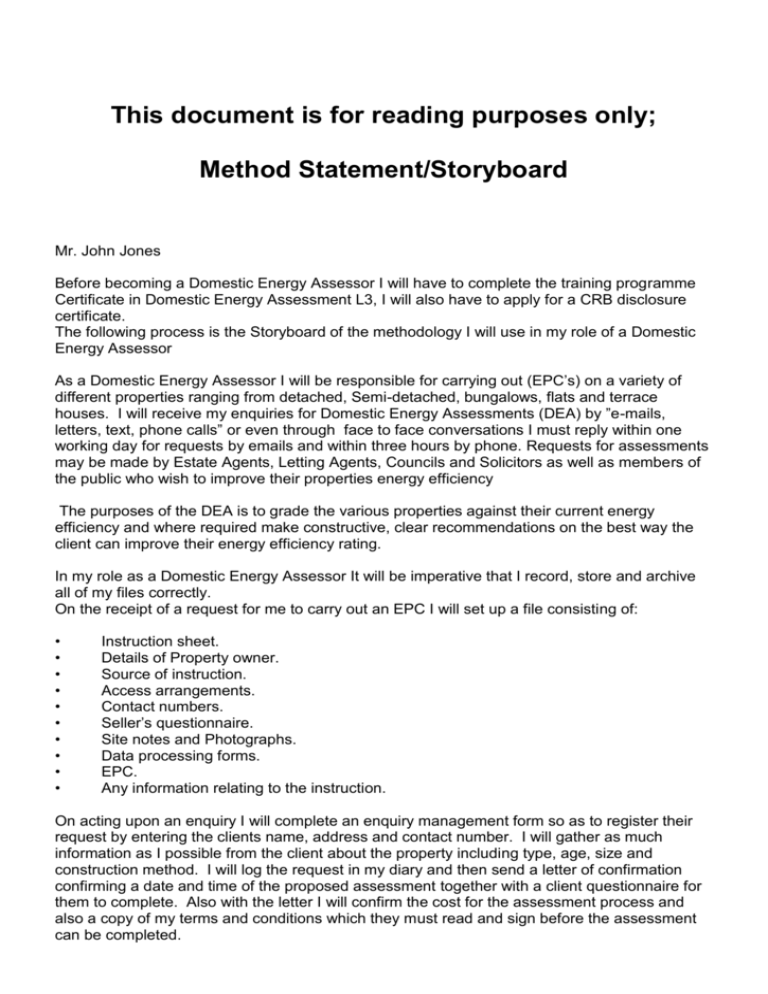Storyboard - The Energy Link
advertisement

This document is for reading purposes only; Method Statement/Storyboard Mr. John Jones Before becoming a Domestic Energy Assessor I will have to complete the training programme Certificate in Domestic Energy Assessment L3, I will also have to apply for a CRB disclosure certificate. The following process is the Storyboard of the methodology I will use in my role of a Domestic Energy Assessor As a Domestic Energy Assessor I will be responsible for carrying out (EPC’s) on a variety of different properties ranging from detached, Semi-detached, bungalows, flats and terrace houses. I will receive my enquiries for Domestic Energy Assessments (DEA) by ”e-mails, letters, text, phone calls” or even through face to face conversations I must reply within one working day for requests by emails and within three hours by phone. Requests for assessments may be made by Estate Agents, Letting Agents, Councils and Solicitors as well as members of the public who wish to improve their properties energy efficiency The purposes of the DEA is to grade the various properties against their current energy efficiency and where required make constructive, clear recommendations on the best way the client can improve their energy efficiency rating. In my role as a Domestic Energy Assessor It will be imperative that I record, store and archive all of my files correctly. On the receipt of a request for me to carry out an EPC I will set up a file consisting of: • • • • • • • • • • Instruction sheet. Details of Property owner. Source of instruction. Access arrangements. Contact numbers. Seller’s questionnaire. Site notes and Photographs. Data processing forms. EPC. Any information relating to the instruction. On acting upon an enquiry I will complete an enquiry management form so as to register their request by entering the clients name, address and contact number. I will gather as much information as I possible from the client about the property including type, age, size and construction method. I will log the request in my diary and then send a letter of confirmation confirming a date and time of the proposed assessment together with a client questionnaire for them to complete. Also with the letter I will confirm the cost for the assessment process and also a copy of my terms and conditions which they must read and sign before the assessment can be completed. Before leaving to go to a property I will leave a copy of my diary with planned visits and expected time, on arrival at a property I will telephone the office to inform them in line with the company Lone Working Policy. I will carry out a risk assessment at all properties in line with Health & Safety legislation. I will introduce myself to the client and display my photographic ID I will then explain to the client, that the assessment, will take approximately 1 hour and that it will be as unobtrusive survey. I will explain that a responsible person should be available while the assessment is being undertaken and that I will require access to all rooms in the property plus outside areas. During the visit I will make rough sketches of the property lodging all room measurements and also taking photographs of specific parts of the building such as boiler type, cylinder, radiator valves and insulation. When I return to the office I will complete all of the paper work required for input into the Stroma Software and produced the EPC report I will send a copy to the client informing them of all my recommendations to improve their energy efficiency rating. Also I will issue an invoice requesting payment for the EPC which will have to be paid in full within 14 working days. All files that I produce must be kept securely and in order by date or in Chronological order to enable easy access if required. If I carry this out correctly I will be working within the Data Protection Act and EPC Legislation. EPC files which are twelve months old must be archived and must be stored for 15yrs to comply with government legislation and for future reference against any complaints or criminal procedures, or just in case the client looses their copy and request another copy for which they will be charged a nominal fee To comply with the Data Protection Act information should be. • • • • • • Processed fairly and lawfully. Consent must be given to collect and hold data. Use personal data for specified and lawful purpose. Data must be adequate, relevant and not excessive. Data must be accurate and up to date. Personal data must not be kept longer than necessary. Personal data must be processed in line with the individual’s rights. • • • They can insist that inaccurate information is corrected. They are entitled to a copy of information held on them. They are entitled to compensation for any breaches. Personal data must be kept secure. A DEA must not let others know their passwords or let visitors read their computer screens, they must not leave paperwork around for others to read they must use a shredder to dispose of personal data they must ensure that all staff are aware of the Data Protection Act. DEA’s who are employed directly will receive instructions from Central Service Centres via emails, texts or mobile phones. DEA’s who work independently will receive instructions from Home Information Pack providers, Estate Agents, Hip pack providers or directly from home owners. Before taking on an EPC a DEA should consider if the property is within their expertise, if the cost of travelling to the property is unfeasible, they should also consider if they have got enough time to carry out the Assessment to the best of their ability. The DEA may charge a lower rate for clients that have a large stock of property’s or a higher rate for one off Assessments. On certain occasions there may be cause for me to refuse the undertaking of an assessment. Reasons for refusal could be: No adult at the property only minors under 16yrs old. Tenants not informed of the assessment Property too far to travel Property taken over by squatters Property in a state of disrepair I will use different types of methods to research the property before carrying out the Energy Performance Assessment. This information will come from, paper sources, government legislation and Internet websites Paper based research resources:There are a number of ways to research by paper this can be done by going to your local library and look in books about the community or in historical documents. I could visit the area and ask neighbours who grew up in the area about the property. I could contact the local authority and ask for information about the property. If the property was a new building I could try to contact the builders to get the required information off them. Web based resources:When I receive a request to carry out an Energy Performance Assessment I can use the AA Auto Route to put in the clients post code which will enable me to find the quickest route and the distance to the property to help me manage my time efficiently. I can access the local authority website via the local government directory www.communities.gov.uk .These sites will give me information relating to the type and age of the property plus if it falls into a conservation area or if it is a listed building as well as access to the legislation I need to refer to in order to ensure that I am working legally. This is important as I will have to make sure the owner of the property is aware that any recommendations on i.e. upgrade of insulation or double glazed windows will be subject to planning permission or building regulations being obtained before undertaking any work. Another useful site I will use when conducting my research is www.google maps. This site displays an aerial view of the property and the surrounding area which could be useful to assess access to the property and parking facilities. I could also use www.landregistry.com which will give me all the information that I require, I would have to join this site for which there is a charge. Government legislation:I will use the Communities and Local Government website to ensure that my work as an energy assessor falls within the Legislation. I am aware as an energy assessor that the legislation for EPCs applies to: Any property that is being put up for sale requires a HIP package which will include an (EPC) Energy Performance Certificate. All rented property requires an EPC. All property built after 2008 require an EPC Every time a property has a new tenant it requires a new EPC. An Energy Performance Assessor is required to keep a copy of an EPC for 15 years as a legal requirement. The building regulations 2004 incorporate legislation inline with EPCs Any temporary building with a planned life of no more two years does not require an EPC. Places of worship do not require an EPC. Any property owner can have an EPC carried out but it is not a requirement for legislation. If I found that it was taking to long gathering the required information on a property because the property is i.e. in a Conservation Area. I would write to the client asking for an assessment to be postponed until the relevant information could be obtained As a Domestic Energy Assessor part of my duties will be carrying out representative sampling for private/social landlords, Estate Agents, Property Developers, Local Housing Authorities or customers who hold large portfolios of housing stock. Whilst carrying out Representative Sampling working alongside the managers/landlords I will be required to group/categorise properties by similar features such as their construction, size, type of property i.e. if it is a flat, terrace, bungalow, detached or a semi-detached property, type of walls and roof type. After being approached by the landlord I will draft a letter that contains a list of all of the categories that I require the housing stock to be divided into. Once I have agreed my time, fees and obtained the relevant data from the landlord I will carry out a visual inspection on a selection of the properties to determine if there are any discrepancies in the data that I have been provided with and to ascertain whether or not I can proceed with the assessment of the percentage of properties that are to be assessed. If the landlord fails to provide sufficient information or fails to provide accurate data then I will offer to assist them. However if the data is not forthcoming then I would not go ahead with the sampling on the basis that the data may be inaccurate or flawed. On a visual inspection I may find that certain properties have had a conservatory built or had insulation pumped into the cavities or extra loft insulation fitted through Government Grants. If after my visual inspection I have identified that more than 10% of the properties are visibly different to the majority of the properties I will have to review my results with the landlord before proceeding with any assessments. As an energy assessment I must ensure that all representative sampling conforms to Government legislation. The number of properties that I will need to inspect will depend on the size of the portfolios. I have included the following groups in table 1 to explain how I would establish the number of properties I would need to visit. Table 1; Data Sample Size Size of Group Sample Size 10 properties or fewer 50% 11 – 50 properties 5 plus (30% of group minus 10) Over 50 properties 15 plus (10% of group minus 50) Example If there are 6 dwellings in a group, at least 3 would need to be surveyed If there are 37 dwellings in a group, at least 14 would need to be surveyed (5 plus 30% of 27) If there were 250 dwellings in a group, at least 35 would need to be surveyed (15 plus 10% of 200) Following my calculations of the number of properties I will sample, I will then have to consider who will notify the tenants that the sampling is being conducted. I will at this stage rely on the landlord to assist me bearing in mind that my time must be used efficiently and effectively and that I may experience some issues that could cause a potential risk there have been previous problems gaining access to the property. The properties could be void. The properties are located in a rundown area with social problems. Once I have agreed the visits I will go ahead and carry out my inspections in a professional manner following all procedures as outlined in method statement 1. When I have completed my assessments and collated the results I will evaluate my findings and produce records. If the results from the sampled properties are found to be typical in that the variation between properties falls within the sample tolerances it will enable properties not sampled to have an Energy Performance Certificate granted. The Typical record is considered to be the median record when ranked by: Increasing Energy Efficiency (SAP) rating; Increasing Environmental Impact; Decreasing floor area. The tolerance levels I will adhere to in order to produce accurate sampling are illustrated in the table below: Table 2; Sample Tolerances Parameter SAP Rating EI Rating Floor Area Tolerance 90% of the sample properties should have a SAP rating within +/-4 SAP points of the SAP rating of the median record; and 95% of the sample properties should have a SAP rating within +/-6 SAP points of the SAP rating of the median record 90% of the sample properties should have a EI rating within +/-4 EI points of the EI rating of the median record; and 95% of the sample properties should have a EI rating within +/-6 EI points of the EI rating of the median record 90% of the sample properties should have a SAP rating within +/-5% of the floor area of the median record; and 95% of the sample properties should have a SAP rating within +/-7.5% of the floor area of the median record Recommendations 95% of reports should contain identical recommendations; and No reports should contain recommendations that would be fundamentally inappropriate for other properties in sample. If the results fall outside of the accepted levels of tolerance I need to consider if the group of properties needs to be sub-divided or excluded from the sampling. If there are no clear traits identified in the results I will talk to the client and decide if there is a need to expand the sampling. The Green Deal and the EPC If a property has an Energy Performance Certificate produced on it and the results identify a potential area of improvement in the recommendations section, then you can look at applying under the Green Deal Initiative for the financing to undertake the improvement works. As long as the energy and cost saving from the improvement is more than the actual cost outlay to undertake the improvement. The Green Deal offers the opportunity for the consumer to repay the cost through their energy bills, spreading the cost and enabling the obligation to be passed on to the future occupiers. There will be considerable consumer protections built in to the framework – this is to protect both the initial occupier and those who follow. The key principal or golden rule, for assessing Green Deal finance is that the charge attached to the bill should not exceed the expected savings, and the length of the payment period should not exceed the expected lifetime of the measures. This is not a government guarantee , but a guideline for customers that , typically, they should be able to expect to gain more efficient, less wasteful properties with no additional net cost from the Green Deal. John Jones Domestic Energy Assessor Type of method statement to be used if you can’t cover any required material. Things that I did not cover in my assessments were; Room in a Roof If I carried out an assessment on a property that had a room in a roof, on measuring up the sizes of the room to meet the criteria to be in this category. The height of the walls from the floor to the junction of the slope of the ceiling should be less than1.8m. The room should be accessible from a fixed stair case which will include a calculations certificate for the rise and going for the purpose of building regulations. The room must be heated by the main heating source of the property. If the walls in the room in a roof are more than 1.8m high at the point were it meets the sloping ceiling then this room is classed as another storey for purposes of the RdSAP data. Alternative wall None of the property’s that I assessed for Energy Performance Certificates had an alternative wall construction therefore I will determine what should be included in the criteria When carrying out my assessments for the EPCs I did not cover an alternative wall. In determining whether an alternative wall is applicable the significant features are construction type, age band and insulation. Walls of the same construction but different thickness within a building part are not considered alternative walls unless they are stone walls. For stone walls assess thickness at each external elevation and at each storey and use alternative wall if the thickness varies by more than 100 mm, . Disregard when less than 10% of total exposed wall area of the building part Converted non domestic If I was to assess a converted non domestic property such as a barn conversion I would perform it in exactly the same way as a conventional Energy Performance Assessment and enter all elements as at the time the building was converted






